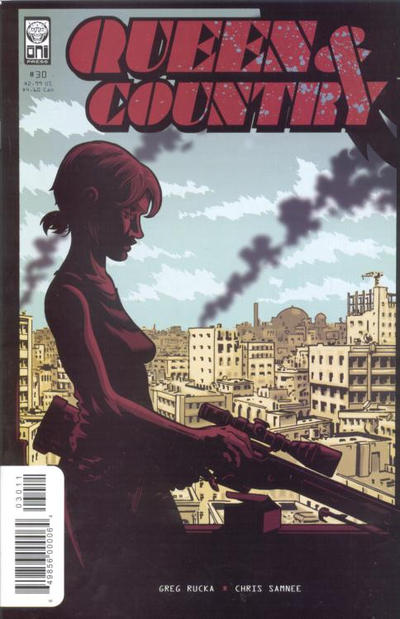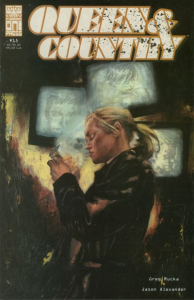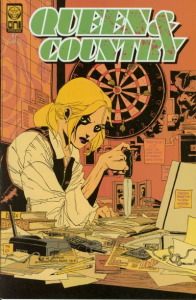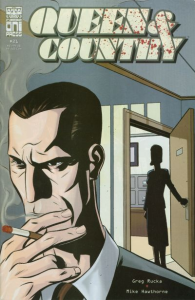July is the month of spy comics here at Gotham Calling.
Let’s kick things off with what is unquestionably one of the all-time greatest spy series in the medium: Queen & Country.
Originally published between 2001 and 2007 by Oni Press, Queen & Country was an ongoing series revolving around the Special Section of the United Kingdom’s Secret Intelligence Service (aka MI6), used for special missions abroad. The ensemble cast was headed by Tara Chase, one of the Section’s three operatives (sometimes referred to as ‘minders’). Because the comic was written by Greg Rucka, Tara was a fleshed out, capable-yet-brooding woman constantly struggling with her inner demons.
The series is set in a gloomy world of anti-climaxes and morally compromised missions undertaken by lonely, frustrated spies. It follows the pulled-back, ‘adult’ tradition of British TV dramas such as The Sandbaggers and Tinker Tailor Soldier Spy, depicting espionage through restrained action, nuanced character development, and, above all, an emphasis on the bureaucratic side of the job, albeit without sacrificing the thrills of the genre in the form of risky assignments and plot twists galore.
A big part of the appeal is the abundant trade jargon that we have to figure out ourselves. Greg Rucka mostly dispenses with the trope of the newbie who serves as our point-of-view character guiding us into this world (I say ‘mostly’ because agents keep dying or being replaced, so newbies do show up every once in a while) – instead, he tends to write in a way that allows readers to gradually decipher the team’s codenames, rules, and institutional framework. The fact that nobody seems like they are acting for our benefit actually makes us feel a little bit like spies ourselves, peeking into this secret circle while piecing together the way everything works.
Whole pages are filled with people striking shadowy deals and talking cryptically in boring offices or exclusive members’ clubs (the latter scenes, I assume, are a kind of homage to Humphrey’s talks with Sir Arnold Robinson in Yes, Minister). Fortunately, though, the various artists excel at building tension by shifting angles and panel designs in order to create the illusion of movement. Plus, Rucka has clearly worked out each beat of the comic’s rhythm – he is a master of the well-placed ‘silent’ panel, giving each scene enough room to breathe.
His scripts (published in the bonus section of the collection Queen & Country: Definite Edition, volume 3) are also packed with subtle moments of characterization, where one line or gesture speaks volumes. For example, in the very first issue, the Director of Operations Paul Crocker gets a lot of shit from his immediate superior, the Deputy Chief of Service Donald Weldon, for having mounted an unauthorized assassination at the request of the CIA…
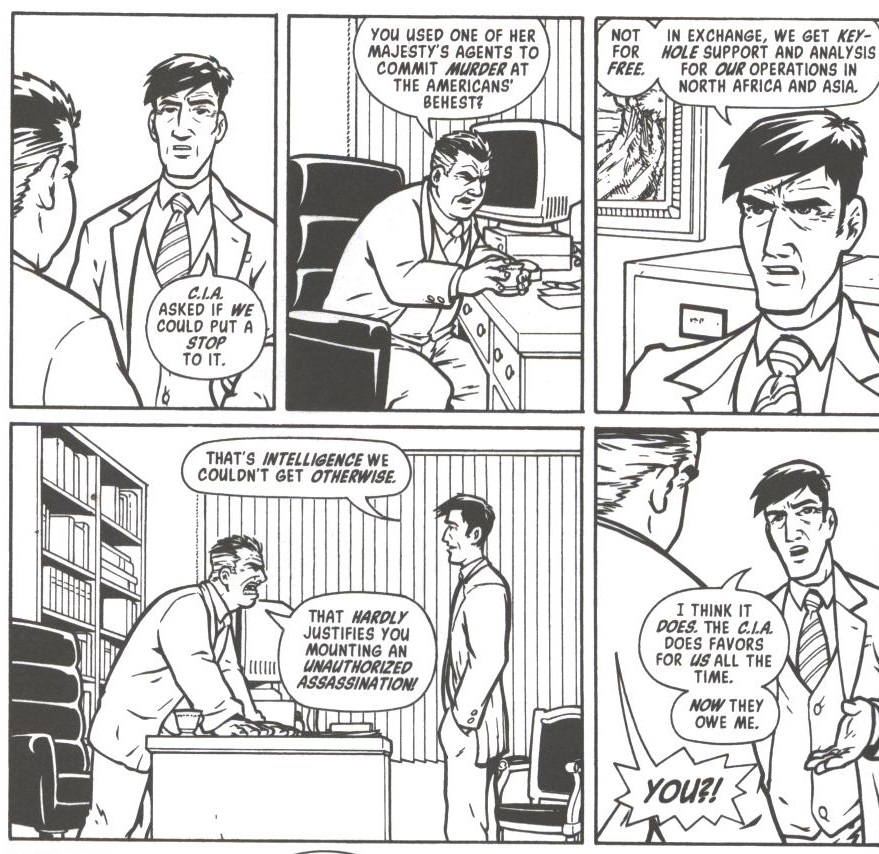 Queen & Country #1
Queen & Country #1
As you can tell from Weldon’s reaction, the fact that Crocker said ‘Now they owe me.’ instead of ‘Now they owe us.’ is quite revealing about his priorities!
Indeed, the series starts off with a bang, as this whole first arc (‘Operation: Broken Ground’) is a pitch-perfect lesson in storytelling. It takes place mostly after Tara has carried out the abovementioned assassination, in Kosovo, and the Russian mob strikes back against the MI6 headquarters, in London. The story neatly establishes the strong-headed Paul Crocker, who desperately wants the MI6 to mount a response, even though technically this should be a job for the domestic security services (MI5), since the attackers are on British soil… In fact, MI6 agents aren’t even supposed to carry guns inside the UK, which forces Crocker to come up with a creative solution.
The thing is that Crocker doesn’t even doubt the MI5 can get to the attackers and arrest them, it’s just that he wants to make sure they die! He comes up with all sorts of pragmatic justifications for it – like the argument that a reputation for vengeance discourages traitors (‘it prevents another Philby or Maclean or Burgess’) – but you can tell he mostly resents the fact that someone messed with his crew. On top of this personal layer and the typical jurisdiction disputes between different branches of the secret services, there is also a political subtext to the story in the sense that most characters seem to agree that British agents can get away with all sorts of behavior abroad that’s considered unacceptable at home.
Queen & Country lasted for 32 issues, encompassing eight story arcs, each named after a specific mission. Because Greg Rucka tried to keep things grounded in the real world, the Special Section dealt with topical threats, which makes it a treat to revisit the series all these years later. The second arc (‘Operation: Morningstar’) came out after 9/11 but was written before… and it shows. It follows a dangerous assignment in Kabul while Tara deals with the frustration of having to stay behind. You can tell the story assumes (and responds to the assumption) that, at the time, more official attention was given to the Taliban’s role in drug trafficking than to their treatment of women, which was certainly not the case after the NYC attacks (as the Bush administration opportunistically co-opted feminist concerns to justify the invasion of Afghanistan). The third arc (‘Operation: Crystal Ball’) was already firmly set in the early War on Terror (pre-Iraq), with the Special Section investigating a possible chemical attack against British nationals. In 2004, we got ‘Operation: Dandelion,’ in which the Section explored the possibility of staging an anti-Mugabe coup in Zimbabwe (thirteen years before the fact).
It’d be nice to see what challenges Tara Chase would face today, although I suspect they’d be a variation of the kind of Russia-centered plots we got in the latest season of Homeland (a pretty cool season, which continued the show’s counterfactual take on an imaginary Hillary presidency). If this is your cup of tea, you’ll probably enjoy the incredible story-arc ‘Operation: Saddlebag,’ in which Tara goes to St. Petersburg to investigate a junior minister who may be selling information to the Russians and things just go from bad to worse.
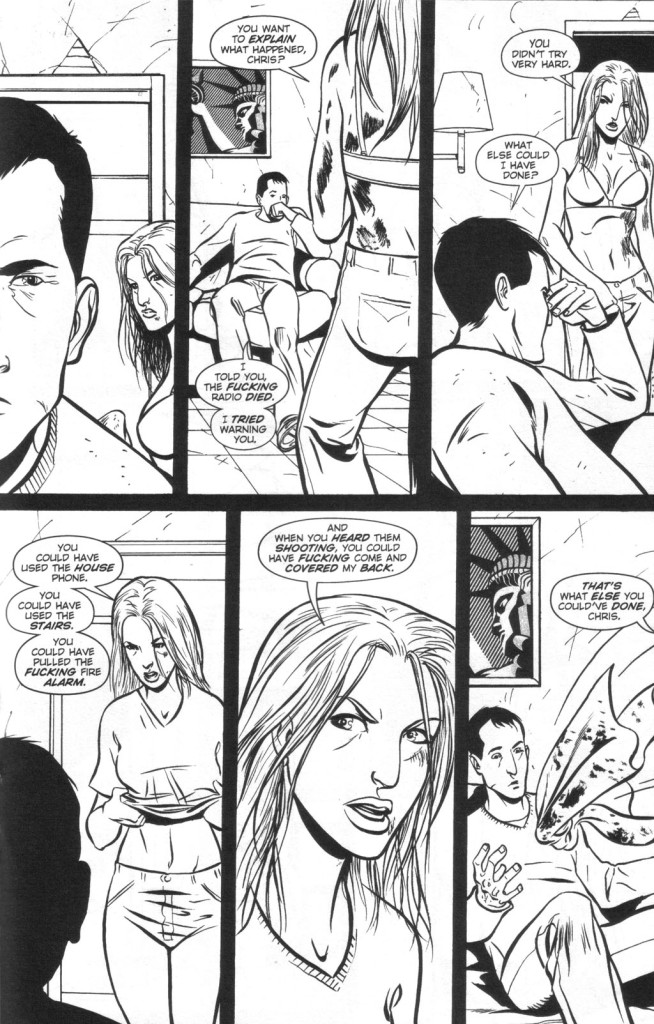 Queen & Country #27
Queen & Country #27
The artists kept changing throughout the series, each with their own distinctive style. Steve Rolston set the bar high in the first arc, especially with regard to the suspenseful field operations. Rolston’s linework was key to establishing the comic’s emphasis on verisimilitude and understated drama (despite some slightly cartoony facial ‘acting’). His sequences in Kosovo have a gritty, realistic feel reminiscent of Joe Sacco’s acclaimed trilogy about the war in the Balkans (Safe Area Gorazde, The Fixer, and War’s End).
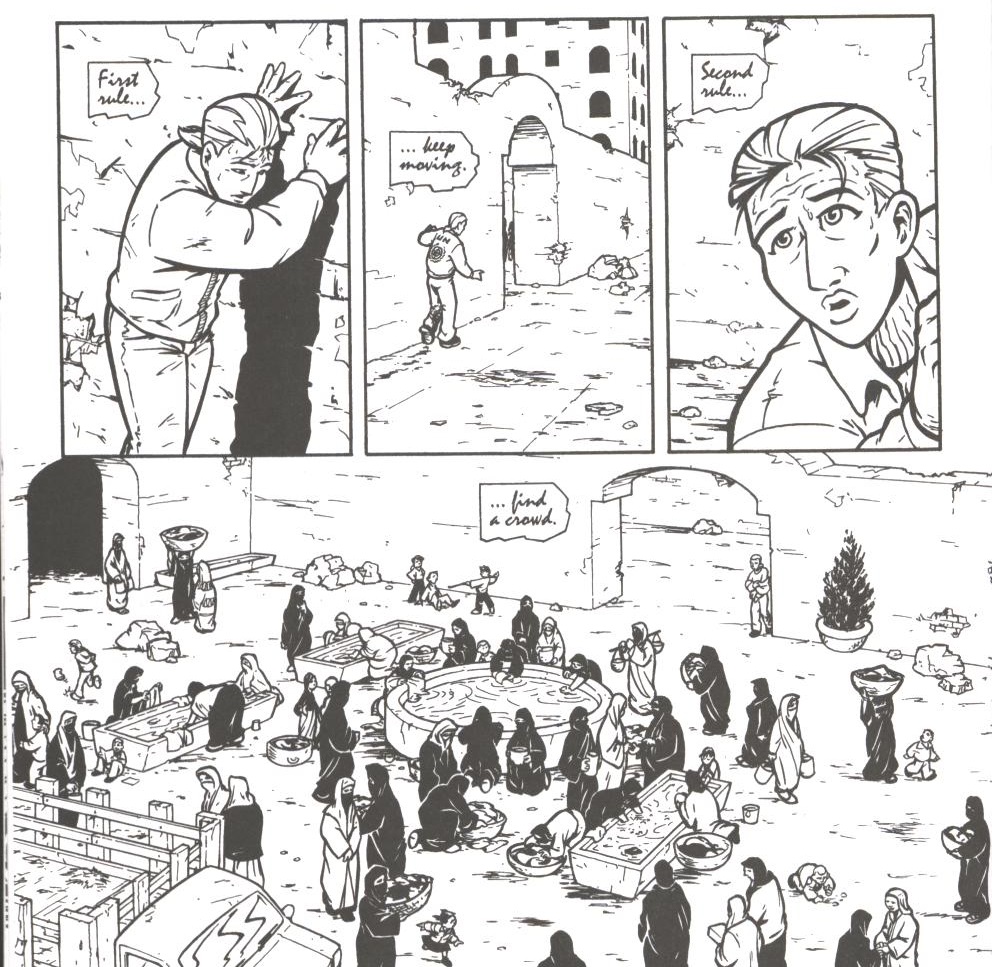 Queen & Country #1
Queen & Country #1
While Brian Hurtt and Carla Speed McNeil mostly stuck to Rolston’s naturalistic-yet-vaguely-cartoony approach, Leandro Fernandez brought in a more stylized design (which I don’t think suited the series quite as well). Mike Hawthorne sort of merged the two approaches and the amazing Chris Samnee pushed the realism to a new degree.
These shifts meant that it wasn’t always easy to recognize every character at the beginning of each story, even if Queen & Country did secure a relatively coherent visual identity overall due to the use of high-contrast inks (if somewhat scratchier in Jason Shawn Alexander’s issues), with plenty of negative space. The chiaroscuro not only gave the comic a quasi-noirish look at times, but it also stressed the point that these people operated in a world of shadows.
Like I mentioned before, the artists were expected to handle quite a bit of wordless narrative – not just the quiet character moments at the office, but also the shootouts and chases in the field. Using very few sound effects, the latter relied heavily on clear drawings with an almost tactile depth and montages worthy of Eisenstein:
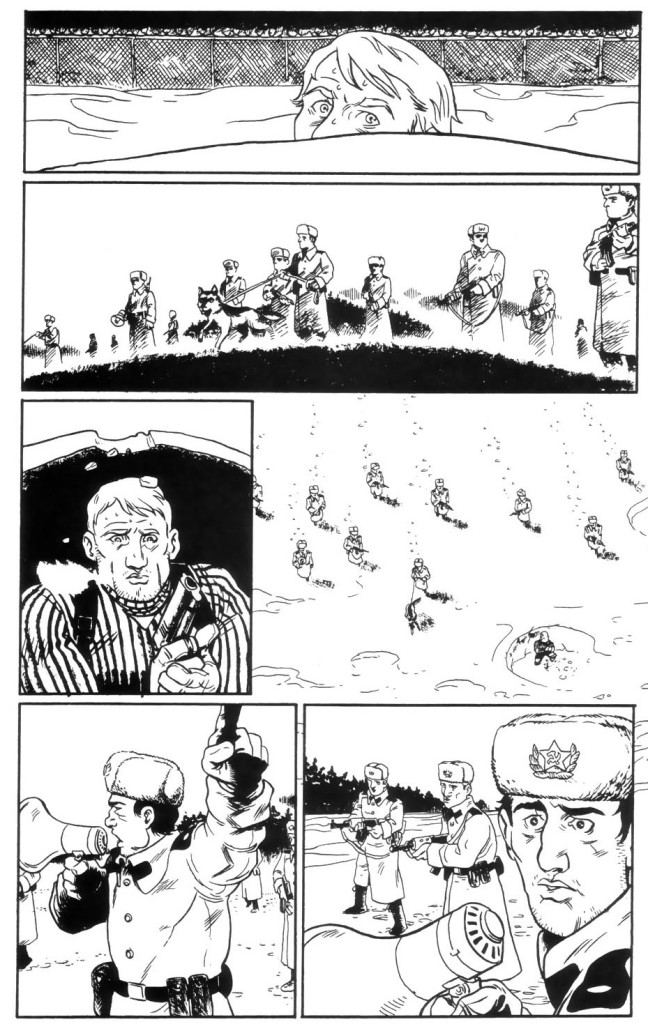
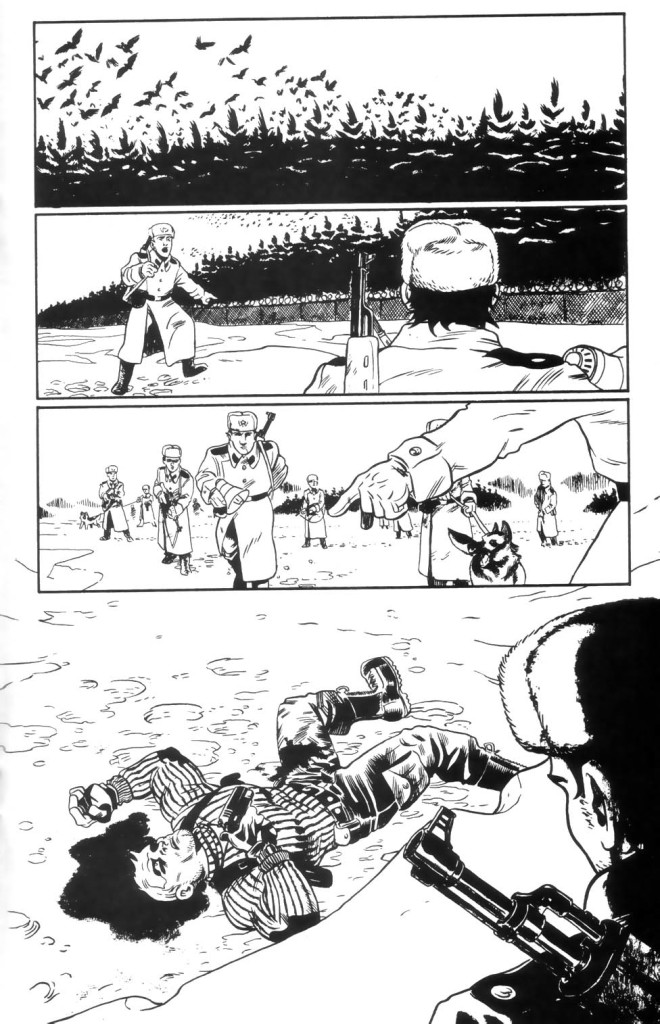 Queen & Country: Declassified #1
Queen & Country: Declassified #1
Besides the main series, there were a few spin-offs, including three Queen & Country: Declassified mini-series fleshing out the background of supporting characters…
The first one – which is best read before the story-arc ‘Operation: Storm Front’ (Queen & Country #16-20) – is a riveting Cold War yarn set in the late 1980s. It follows a young Paul Crocker trying to get a possible defector out of Prague and it includes Crocker’s first run-ins with Don Weldon and Francis Barclay (who replaced the Chief of Service – aka C – in later issues of the main series). Even though the tale is exceptionally action-packed, it ruthlessly rejects all the glitz and glamour of the James Bond narratives.
The second mini follows another minder, Tom Wallace, investigating a murder in Hong Kong shortly before the 1997 handover. It was illustrated by Rick Burchett, whose retro style gave the comic a moody look reminiscent of the 1960s’ Hong Kong TV series (which started out as a spy show before gradually moving into more crime noir territory).
Finally, a third Declassified mini focused on Nick Poole (a minder who joined the team in ‘Operation: Dandelion’) during his time as an SAS corporal in Northern Ireland. It was illustrated by Christopher Mitten and written by Antony Johnston, who did a good job of capturing Rucka’s mature tone.
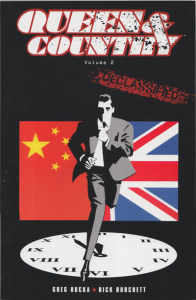
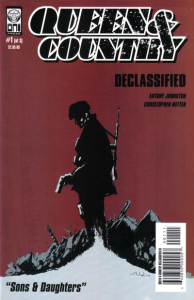
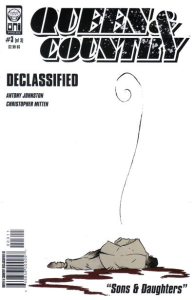
In addition, Rucka wrote three prose novels starring Tara Chace. I’ve read the first two.
2004’s A Gentleman’s Game, which takes place between the arcs ‘Operation: Saddlebag’ and ‘Operation: Red Panda,’ kicks off with a sequence that disturbingly anticipates the London bombings of the following year. It goes on to alternate between the strained response of the intelligence services and the gut-wrenching story of a recruited jihadist, inexorably building up to their confrontation in the Middle East… which is when the narrative takes an engrossing turn, forcing the various characters to deal with the surprising fallout of the operation. The plot really shifts into high gear in the final stretch, as the different agencies all try to play each other. (The title is doubly ironic: not only does the novel star a female agent, but there is barely any sportsmanship in the callous spy world depicted inside.)
On the one hand, the book feels less sophisticated than the comic, with the narration feeding readers information in a relatively direct way instead of challenging them to keep up and work out what’s going on. On the other hand, some fans may find it neat to get a bit more background, including the expansion of Tom Wallace’s role or this insight into Paul Crocker’s reasoning for always meeting his CIA contact in Hyde Park:
“It was one of the oldest espionage clichés in the Firm, certainly outdated, and in the current day and age of parabolic microphones and laser-beam listening devices quite possibly tragically insecure. But walking in Hyde Park was still Paul Crocker’s favorite method of information exchange with the CIA, and he balanced the potential of compromise with the benefit of being able to talk out of the office, away from the alarmist eye of the Deputy Chief and the distrust of C.”
Or the reasons behind the mission codenames, only hinted at in the comics:
“Contrary to popular belief, mission names were chosen entirely at random, from a computer-generated list of suggestions. It was a mystery to her exactly for what criteria the computer searched, and she suspected – as did most of the Ops Room staff – that the nameless technician who had written the program in the first place had done so with a Pythonesque relish of the absurd.”
2005’s Private Wars, which takes place immediately after ‘Operation: Red Panda’ and basically wraps up what was meant to be the ‘first season’ of Queen & Country, is another solid entry into the series. Much of it revolves around an intense mission in Uzbekistan but, once again, every time you think you have things figured out, the book throws a new curveball at you. Greg Rucka seems more confident in his readers, filling the prose with acronyms (you’ll want to keep a finger on the helpful glossary at the beginning) and fearlessly taking his time with the departmental machinations.
Ultimately, Rucka plays to the medium’s strengths and the result is a couple of smart, middlebrow page-turners about post-9/11 espionage, albeit not as witty as Robert Harris’ The Ghost or John le Carré’s A Delicate Truth (or, better yet, le Carré’s Absolute Friends). With its multifaceted look at the ambiguous politics of the secret services and with a complicated female protagonist whom Rucka refuses to objectify, A Gentleman’s Game certainly doesn’t deserve the misleading tagline ‘She’s a spy who plays by only one rule: her own.’ nor the sexist Entertainment Weekly pull-quote the editors at Bantam chose for the back-cover: ‘Chace is the most tough-as-nails-but-still-shag-worthy secret agent since Mata Hari.’
Also of interest, back in 1998 and 2000 Oni Press had already published a couple of Rucka-written black & white comics about international intrigue (with crisp art by Steve Lieber). The Antarctica-set mini-series Whiteout and its sequel Whiteout: Melt are still quite rough compared to the heights of Queen & Country, yet they make the most out of their fascinating location. Besides, not only do we get another compelling lead in US Marshal Carrie Stetko (yep, a fleshed out, capable-yet-brooding woman constantly struggling with her inner demons), but one of the supporting characters reads like an early draft of Tara Chase. (In the first issue of Q&C, Tara actually mentions: ‘The last time I was this cold I was at the South Pole.’ – so Whiteout can be taken as a prelude to the subsequent series.)
Finally, fans of Queen & Country may want to check out Greg Rucka’s excellent run on the comic book series Checkmate, which reimagined the complex world of espionage in the DC Universe, combining intelligent spy fiction with fantastic superheroes.

